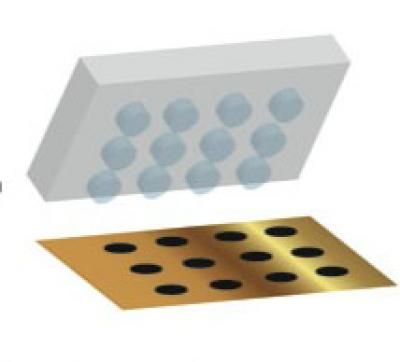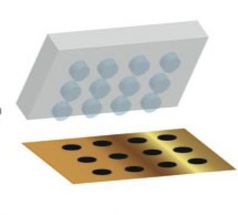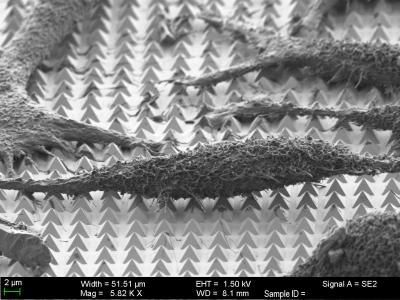Conducting polymer films decorated with biomolecules for cell research use
The ability to create conducting polymer films in a variety of shapes, thicknesses and surface properties rapidly and inexpensively will make growing and testing cells easier and more flexible, according to a team of Penn State bioengineers.

This illustrates conducting polymer films, grown in a patterned fashion, that are decorated with variety of biomolecules such as antibodies or proteins (represented by the flowers) to attract cells or other biomolecules (represented by the butterflies). This artistic image, created by SooHyun Park, represents the focus of this article on generating patterned films of conducting polymers with different geometries, surface chemistries, and biomolecules using the novel method of hydrogel-mediated electropolymerization towards the application in biosensing and cell/tissue engineering.
SooHyun Park, Penn State

This is an image of stamp and substrate.
Sheereen Majd, Penn State


"The ultimate goal of this collaborative project is to be able to create a substrate for growth and manipulation of cells," said Sheereen Majd, assistant professor of bioengineering. "Cells on a surface need to recognize biomolecules like extracellular matrix proteins to be able to adhere and grow. We ultimately would like to be able to use these polymer films to manipulate adhesion, growth, proliferation and migration of cells." Majd and her team are creating patterned films of conducting polymers on gold substrates by electrodeposition through hydrogel stamps. They report their results in Advanced Materials.
The researchers create their hydrogel stamps from agarose -- a sugar extracted from seaweed -- poured into molds. While most of the current experiments use arrays of dots, because the researchers use molded stamps, a wide variety of shapes -- dots, squares, lines -- are possible. The stamp is dipped in a solution of monomer and a dopant and placed on the gold surface. An electrical current through the hydrogel and gold polymerizes the monomer and dopant at the surface. If a biomolecule of interest is also included in the stamping solution, it becomes embedded in the polymer film as well.
Because the presence of dopant is important for the electrical conductivity of these polymers, only areas where monomer and dopant exist together form conductive films of polymer. The process takes from one to two minutes and the longer the current is applied, the thicker the film.
The researchers were able to produce a series of films using the same monomer but different dopants and biomolecules by altering the solution on various parts of the stamp. In this way researchers can change the surface properties and functionality of the films. The stamp can also be used multiple times before re-inking becomes necessary, simplifying and speeding up the process.
Creating arrays of different biomolecules and different shapes in conducting polymers is especially important when studying excitable cells like neurons or muscle cells because they react to electricity.
Conducting polymer arrays will allow manipulation of cells using chemical and electrical signals, expanding the ways cells can be treated. Varying films laid down on one substrate can put multiple experiments all in one place.
























































